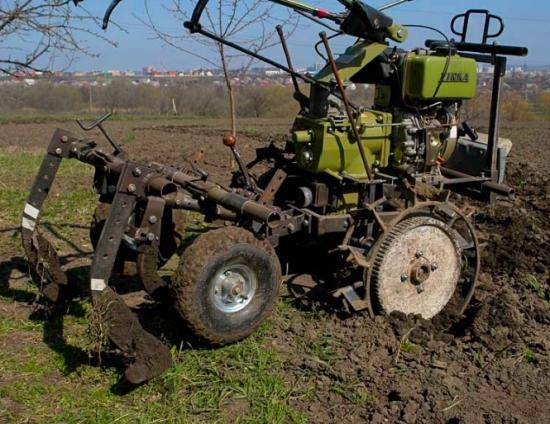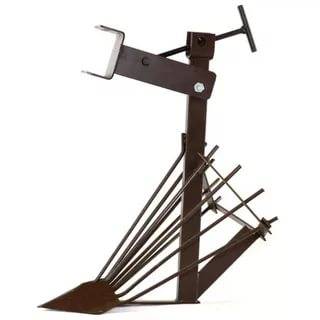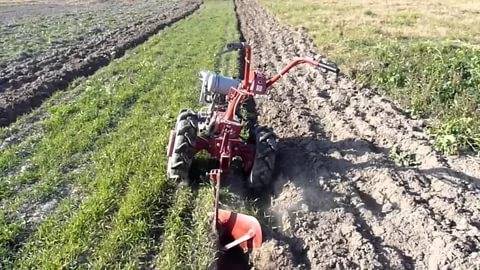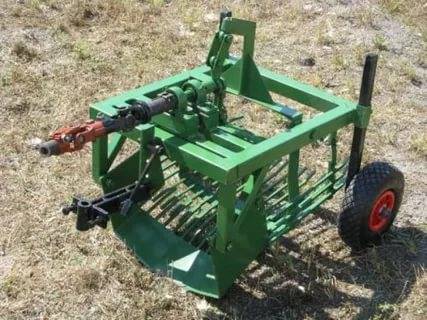Content
The advantage of motor cultivators over walk-behind tractors is maneuverability and ease of control, but they are weaker in power. Such gardening equipment is more intended for loosening the soil in the garden, greenhouse or vegetable garden. However, many gardeners carry out the digging of potatoes with a motor-cultivator, attaching a trailed mechanism to it.
Why it is sometimes necessary to speed up the harvest
Gardeners know that tame harvesting potatoes under the shovel is a complex and time-consuming process. First, you have to remove everything from the garden weeds and large dry tops of potatoes. Further, with a shovel or digging in the ground with a pitchforkthrowing tubers to the surface. Behind them, the holes still need to be buried so as not to sprinkle the rolled potatoes dug from the next row in them.
Manual digging potatoes happens more than one day, which is especially unacceptable when bad weather is approaching. With the onset of the rainy season, tubers that have not been dug begin to re-germinate. Many potatoes rot or taste changes. If the harvest is excavated after rain, all tubers covered with mud will have to be washed, which is why they are poorly stored in the cellar in winter. A motor cultivator or walk-behind tractor helps to avoid all problems with harvesting, and to speed up this process.
Which garden equipment is better to give preference
Garden equipment is produced in various modifications. You can watch the video of how motor-cultivators, mini-tractors and walk-behind tractors work in different areas of land. Some machines are made for a narrowly focused performance of tasks, while others can do almost anything in the garden.
Walk-behind tractors are multifunctional. The equipment is adapted to work with additional attachments: plow, grass mower, potato digger and others. The motor-cultivator is designed mainly for loosening the soil, but it is a machine, therefore it is used by many gardeners for digging potatoes.
It is necessary to buy the unit taking into account the type of work it is designed for, as well as the size of the garden and the composition of the soil:
- If the digging of potatoes takes place on a plot of more than five acres, then only a walk-behind tractor with a capacity of 5 liters or more will cope with the task. from. Such a car is expensive, more difficult to operate and weighs at least 60 kg.
- For a summer cottage garden of 2-3 acres, it will be enough to use a motor-cultivator. The video of the different models presented shows how easy it is to operate such a technique. The weight of different cultivators varies from 10 to 30 kg. The power of the units is in the range of 1.5-2.5 liters. from. If you wish, you can attach a potato digger to the cultivator yourself, weld metal wheels, and use it where there is light soil.
- It is hard for a motor cultivator to work in vegetable gardens from 3 to 5 acres. Here, to dig out potatoes, it is better to use a walk-behind tractor with a low power from 3 to 5 liters. from. Such units weigh in the range of 40-60 kg.
Each vehicle can be equipped with a factory-made or home-made tow hitch. Conventionally, all potato diggers are divided into two types:
- The simplest fan models consist of a cutting part, on top of which metal rods are welded.The dug up potatoes fan out to the side, and the soil is sifted out through the cracks between the rods.
- Vibrating potato diggers consist of a cutting part - a ploughshare and a vibrating sieve.
Next, we will look at ways to dig up potatoes with each type of towing mechanism.
Harvesting with different types of potato diggers
So, the harvesting process begins with the installation of a potato digger on the machine, after which the soil layer is cut along with the tubers.
Cleaning with a fan potato digger
The principle of digging up potatoes with such a device resembles the use of a shovel, only instead of its own power, the power of a motor-cultivator is used. The hitch is fixed at the rear of the machine at a certain angle. The slope is set individually, so that the nose of the digger does not go deep into the ground and pry all the potatoes. If the tilt is incorrect, the potato digger will wedge into the ground or cut the potatoes.
Angle adjustment is done with holes on the digger bar. When positioned correctly, the hooked tubers are thrown onto a fan of twigs. Here the soil is sifted out, and the crop remains in the garden behind the motor-cultivator.
Vibrating potato digger
With this mechanism digging potatoes with a motor-cultivator on rows up to 40 cm wide and up to 20 cm deep. Although such a trailed one is best used with a walk-behind tractor. The cultivator simply does not have enough power to pull it with it.
Rows of potatoes are cut by a ploughshare. The tubers along with the soil fall on the vibrating grate, where the soil is screened out. The net crop is thrown into the garden, where it is then simply collected in a bucket. Some of these models of potato diggers have a conveyor belt to improve the process of movement and cleaning of tubers.
The video demonstrates the harvesting of potatoes with a walk-behind tractor:
Outcomes
For mechanical harvesting, there is one golden rule: to reduce losses, the rows must be made as even as possible.













